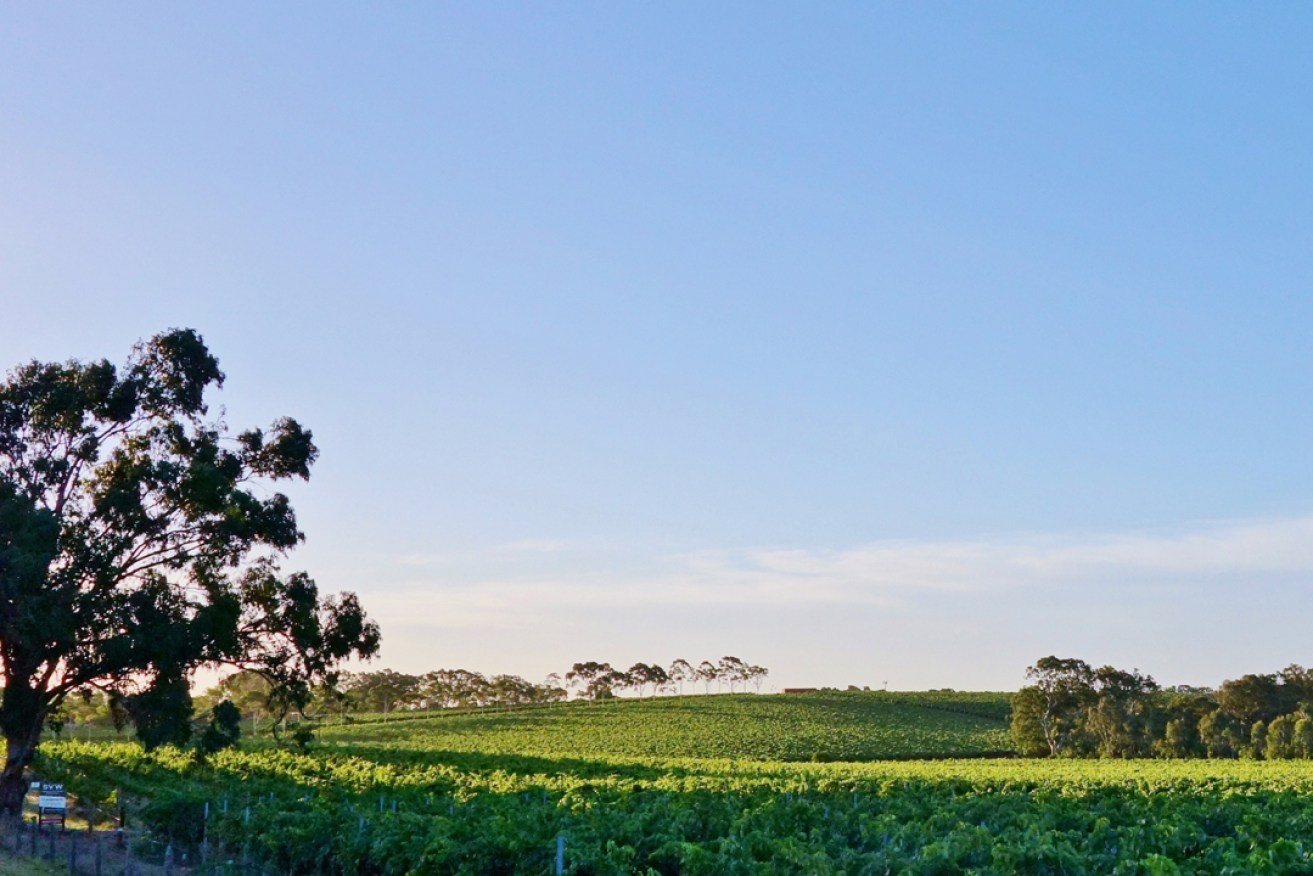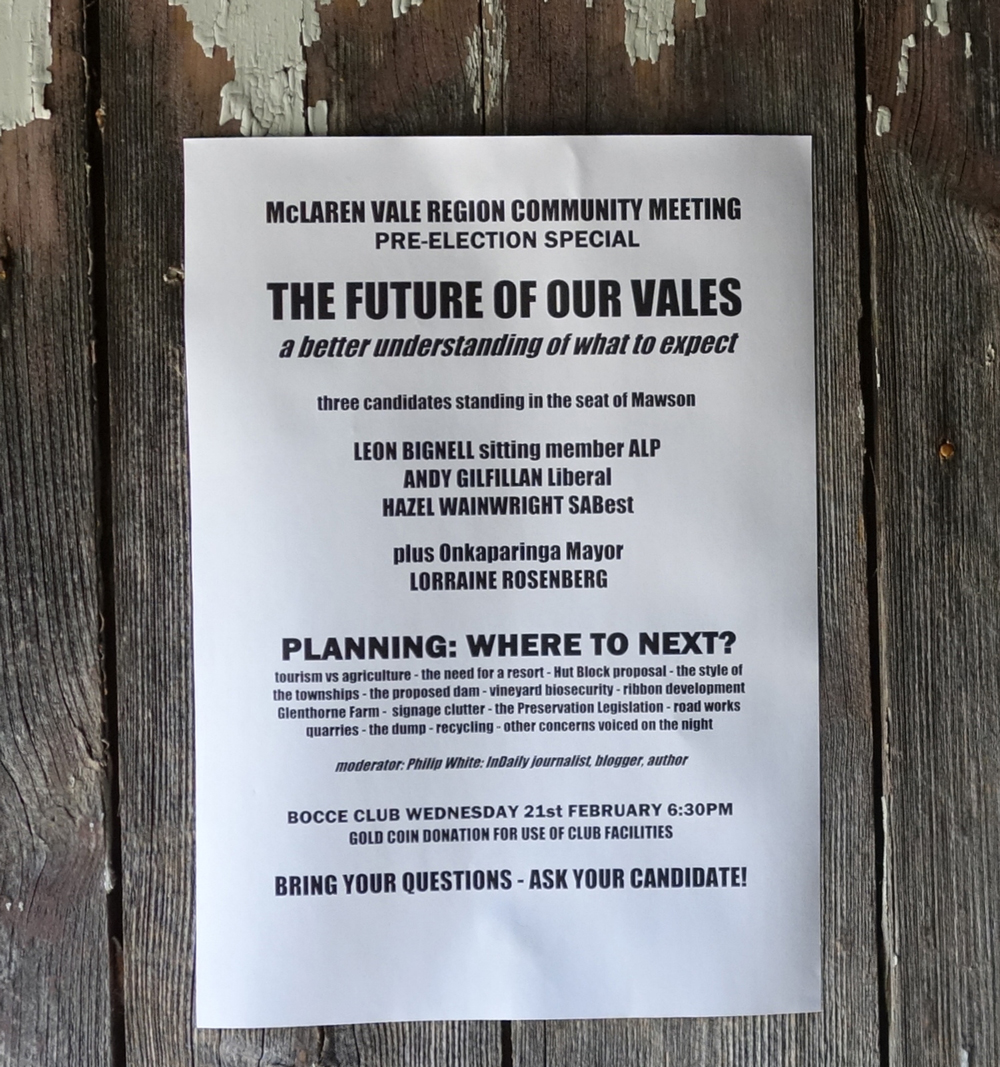The future – political and otherwise – of the Vales
Philip White reports that the three major candidates running for election in the wine region he loves agree on critical issues.


The Hut Block - proposed site of a new hotel.
We had a meeting of interested residents of McLaren Vale in the Boccé Club.
The big hall quickly filled. Folks came from McLaren Flat, Blewett Springs, Willunga and their surrounds and the suburbs along the coast. The three major candidates for the seat of Mawson – sitting ALP Member Leon Bignell, Liberal candidate Andy Gilfillan and the SA Best/Xenophon candidate Hazel Wainwright – agreed to sit onstage with the Onkaparinga Mayor, Lorraine Rosenberg. I led them through a brisk agenda of planning issues for an hour, then they took questions from the floor for another hour.
There was no biffo. Rarely have I seen a public meeting where people came so early, in spite of vintage getting its throttle to the floor. Many of the longstanding sage identities and Vales venerable were prominent.
Considering the fractal nature of this election, with three gangs loose in the yard instead of the old duopoly, it was encouraging to see how the candidates agreed on several critical issues.
Glenthorne Farm, the 200-hectare scientific research station on O’Halloran Hill, is neither within the seat of Mawson or the official boundary of McLaren Vale as delineated in the McLaren Vale Character Preservation (McLaren Vale) Act 2012. But it does lie within the official, internationally-gazetted Geographical Indications boundary of the region, and as such, is seen by many in the south as their last bastion of fresh green country in a relentless onslaught of suburbia.
In 2001 this former defence and CSIRO property was gifted to the University of Adelaide which agreed to preserve and conserve it and use it for agriculture, horticulture, oenology, viticulture, buffer zones and for community recreation while university research, education and winemaking continued.
Contrary to the highly specific deed, the university has long sought to subdivide the land for quick cash. It has never really attempted to conform to the deed, which repeatedly states that urban development is not only forbidden but even thinking about or planning it is a breach of the deed.
All three candidates were adamant that there be no housing subdivision on Glenthorne should they take power. Both Labor and Liberal have discussion briefs on the internet, in the hope of reaching some community agreement about possible uses for the site. The Libs’ plan includes a shooting range and gun club; Labor wants a mini farm so local kids can learn those old agricultural crafts. Neither lot will say what’s wrong with the conditions of the current deed other than to suggest the university is the wrong owner: Bignell made no bones about taking the farm back from the university and getting straight on with establishing the country’s primary collection of vine cultivars.
Another issue which had locals concerned was the 150 suite five-star resort Richard Hamilton plans to instal on his Hut Block Vineyard between The Salopian Inn and Wirra Wirra. An hotel with two restaurants, a café, an indoor swimming pool, a gymnasium, a day spa, conference facilities and a two-storey carpark would make a huge impact on the aspect of that agricultural precinct well outside the surveyed town boundary.
All three candidates agreed that the Hut Block is the wrong site; the Mayor explained the developer has been advised to re-apply as the initial application did not conform to the restrictions in the protective legislation.
Ultimately the decision could be hand-balled to the Planning Minister John Rau, who’s also the Attorney-General and Deputy Premier. Bignell claimed he would have little trouble convincing his colleague the development was needed but should conform to the preservation legislation and therefore be constructed within the town boundary instead of being imposed on prime agricultural land.
Which led to some intense discussion about the look of the towns as they fill. If the Government’s exemplar development, the droll, hyperintense housing now covering Seaford Heights is any guide to what we can expect, lord have mercy on our poor souls.
This, in turn, led to repeated discussion about forming a regional residents’ association as many folk agreed there was a communications gap between governments and citizens, and planners extant could sure use some more forceful guidance about their ratepayers’ preferences for the look and feel of their townships.
The politics of water in the McLaren Vale region aren’t quite equal to the treacherous scandals unfolding in the Murray-Darling Basin, but they nevertheless maintain their own provincial air. As the irrigating vignerons of the vignoble use recycled water from the intensive housing along the coast, there are contentious issues to address about storing more of this water in a major dam, so more growers have ready access to it. Not to mention those who’d like to make some money out of it.
Local wine businessmen wanted to build this on Bowering Hill, the last place along the coast where the vines can actually grow down to the sea. Those friends of the Willunga Basin who spent years fighting to save those Bowering coastal slopes from development are adamant it should be anywhere but there. There’s talk of waterproofing old sand quarries for this storage; even putting the water into the aquifers for pumping. Watch this space.
 Bignell insisted the best site is near the current storage, on the inferior black clay west of the Aldinga airport.
Bignell insisted the best site is near the current storage, on the inferior black clay west of the Aldinga airport.
There was some discussion about the local roadways and whether or not the newly-widened Main South Road needed an overpass at Tatachilla Road – maybe – and then popular calls to have the railways extended further into the vignoble. Back where they used to be.
Another unresolved mess is the region’s burgeoning mountains of plastic waste: since China no longer accepts the world’s junk it seems we’re just stacking plastic into old quarries that bleed straight into the aquifer and then the sea. Another one for the new residents’ association to address once this election’s done and vintage is in the tank.
As convenor and moderator of this gathering, I was probably too busy on the night to best evaluate the participants’ performances, but I gotta say Kangaroo Islander Andy Gilfillan is a good honest soul, successful organic farmer, and earnestly well-intentioned. Good bloke.
Hazel Wainwright, graphic designer and Onkaparinga councillor seems a little unsure of how she fits across two tiers of government but she’s certainly not the only one in the rookie Xenophon cabal to face that learning curve. Her self-assuredness and sheer energy might get her there.
These folks sat in contrast to Bignell, who was polished and practised in comparison, and took the agenda quite forcefully, dealing deftly with issues, as he does. He knows how to make the most of his huge advantages as a minister, Cabinet member and long-term holder of the seat.
I can’t comment on whether he looks more at home campaigning on Kangaroo Island than Andy Gilfillan appears when he faces such a roomful of eager souls in this northern extreme of what has become a most intriguing electorate.
Similarly, I can’t imagine how Hazel Wainwright would frame her will to the rugged determination of the Islanders. But I have my suspicions.
drinkster.blogspot.com




